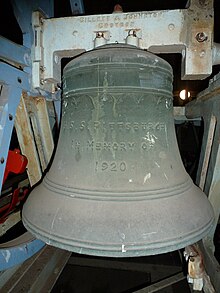
USS Missouri (BB-63) is an Iowa-class battleship built for the United States Navy (USN) in the 1940s and is currently a museum ship. Completed in 1944, she is the last battleship commissioned by the United States. The ship was assigned to the Pacific Theater during World War II, where she participated in the Battles of Iwo Jima and Okinawa and shelled the Japanese home islands. Her quarterdeck was the site of the surrender of the Empire of Japan, which ended World War II.

USS Brooklyn (ACR-3/CA-3) was the third United States Navy armored cruiser, the only one to be named at commissioning for a city rather than a state.
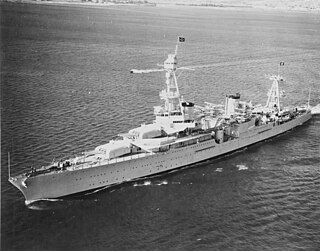
USS Houston (CL/CA-30), was a Northampton-class cruiser of the United States Navy. She was the second Navy ship to bear the name "Houston".
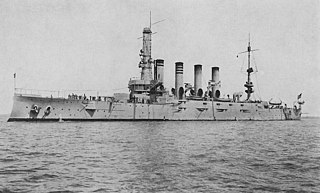
The first USS West Virginia (ACR-5/CA-5), also referred to as "Armored Cruiser No. 5", and later renamed Huntington, was a United States Navy Pennsylvania-class armored cruiser.

The second USS California (ACR-6), also referred to as "Armored Cruiser No. 6", and later renamed San Diego, was a United States Navy Pennsylvania-class armored cruiser.
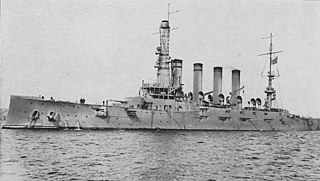
The second USS Maryland (ACR-8/CA-8), also referred to as "Armored Cruiser No. 8", and later renamed Frederick, was a United States Navy Pennsylvania-class armored cruiser.

USS New York (ACR-2/CA-2) was the second United States Navy armored cruiser so designated; the first was the ill-fated Maine, which was soon redesignated a second-class battleship. Due to the unusually protracted construction of Maine, New York was actually the first armored cruiser to enter U.S. Navy service. The fourth Navy ship to be named in honor of the state of New York, she was later renamed Saratoga and then Rochester. With six 8-inch guns, she was the most heavily armed cruiser in the US Navy when commissioned.

USS Colorado (ACR-7), also referred to as "Armored Cruiser No. 7", and renamed USS Pueblo (CA-7) in 1916, was a United States Navy Pennsylvania-class armored cruiser. She was the second US Navy ship named Colorado, and the first to be named after the State of Colorado. The first, Colorado, was named for the Colorado River.

The first USS South Dakota (ACR-9/CA-9), also referred to "Armored Cruiser No. 9", and later renamed Huron, was a United States Navy Pennsylvania-class armored cruiser.

The first USS Chicago was a protected cruiser of the United States Navy, the largest of the original three authorized by Congress for the "New Navy" and one of the U.S. Navy's first four steel ships.

The seventh USS Washington (ACR-11/CA-11/IX-39), also referred to as "Armored Cruiser No. 11", and later renamed Seattle and reclassified CA-11 and IX-39, was a United States Navy Tennessee-class armored cruiser. She was laid down on 23 September 1903 at Camden, New Jersey, by the New York Shipbuilding Corporation, launched on 18 March 1905, sponsored by Miss Helen Stewart Wilson, daughter of United States Senator John L. Wilson of Washington state, and commissioned at the Philadelphia Navy Yard on 7 August 1906, Captain James D. Adams in command.

USS Chicago (CL/CA-29) was a Northampton-class cruiser of the United States Navy that served in the Pacific Theater in the early years of World War II. She was the second US Navy ship to be named after the city of Chicago. After surviving a midget submarine attack at Sydney Harbour and serving in battle at the Coral Sea and Savo Island in 1942, she was sunk by Japanese aerial torpedoes in the Battle of Rennell Island, in the Solomon Islands, on 30 January 1943.

USS Dolphin (PG-24) was a gunboat/dispatch vessel; the fourth ship of the United States Navy to share the name. Dolphin was the first U.S. Navy ship to fly the flag of the president of the United States during President Chester A. Arthur's administration, and the second Navy ship to serve as a presidential yacht.

USS North Carolina (ACR-12/CA-12) was a Tennessee-class armored cruiser of the United States Navy. The ship was built by Newport News Shipbuilding; she was laid down in March 1905, launched in October 1906, and was commissioned in May 1908. The final class of armored cruisers to be built for the US Navy, North Carolina and her sisters were armed with a main battery of four 10-inch (254 mm) guns, and were capable of a top speed of 22 knots.

USS Montana (ACR-13/CA-13), also referred to as "Armored Cruiser No. 13", later renamed Missoula and reclassified CA-13, was a Tennessee-class armored cruiser of the United States Navy. She was built by the Newport News Drydock & Shipbuilding Co.; her keel was laid down in April 1905, she was launched in December 1906, and she was commissioned in July 1908. The final class of armored cruisers to be built for the US Navy, Montana and her sisters were armed with a main battery of four 10-inch (254 mm) guns, and they were capable of a top speed of 22 knots.
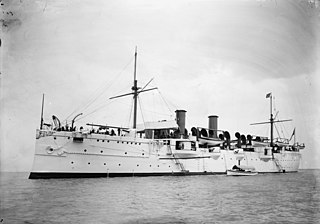
The fourth USS Philadelphia (C-4) was the sixth protected cruiser of the United States Navy. Although designed by the Navy Department, her hull was similar to the preceding British-designed Baltimore, but Philadelphia had a uniform main armament of twelve 6-inch guns.

USS Birmingham (CS-2/CL-2), named for the city of Birmingham, Alabama, was a Chester-class scout cruiser, reclassified a light cruiser in 1920. Entering service in 1908, the ship became known for the first airplane takeoff from a ship in history in 1910. During World War I, Birmingham escorted convoys across the Atlantic. The cruiser was decommissioned in 1923 and sold for scrap in 1930.

The Pennsylvania class of six armored cruisers served in the United States Navy from 1905 to 1927. All six were renamed for cities 1912–1920, to make the state names available for the new battleships beginning with the Pennsylvania-class battleships. All of these served during World War I, with California being the only ship of the class to be lost. The remaining five armored cruisers were scrapped between 1930 and 1931 in accordance with the London Naval Treaty.

USS Olympia (C-6/CA-15/CL-15/IX-40) is a protected cruiser that saw service with the United States Navy from her commissioning in 1895 until 1922. She is currently a museum ship in Philadelphia.

The Tennessee-class cruisers were four armored cruisers built for the United States Navy between 1903 and 1906. Their main armament of four 10-inch (254 mm) guns in twin turrets was the heaviest carried by any American armored cruiser. Their armor was thinner than that of the six Pennsylvanias which immediately preceded them, a controversial but inevitable decision due to newly imposed congressional restraints on tonnage for armored cruisers and the need for them to be able to steam at 22 knots. However, the fact their armor covered a wider area of the ship than in the Pennsylvanias and their increased firepower caused them to be seen by the Navy as an improvement.



